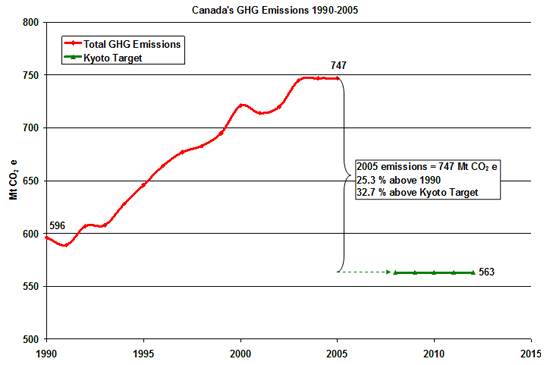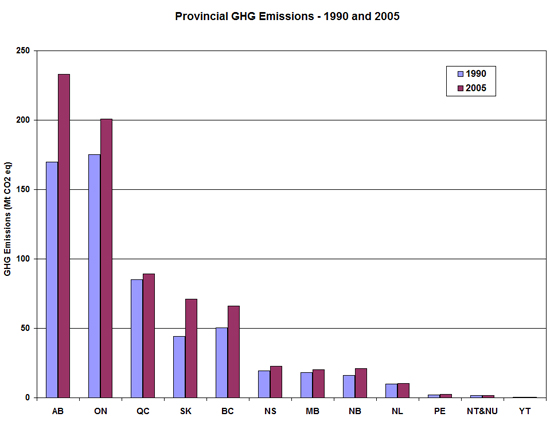Canada now 32% above Kyoto target
The figures, released as part of obligations under the United Nations Framework Convention on Climate Change (UNFCCC), show that Canada’s GHG emissions in 2005 were 747 megatonnes (Mt), representing an increase of 25.3% over the 1990 level of 596 Mt. This places the country 32.7% above its Kyoto Protocol target, which calls for a 6 percent reduction from the 1990 level.
GHG emissions rose by 0.3% from 2003 to 2004, and then remained stable. According to the report, the slow down in GHG growth appears to be a result of provincial actions to reduce coal consumption and increase nuclear and hydroelectric generation, as well as reduced demand for heating fuel due to warmer winters, and a reduced rate of increase in fossil fuel production.
However, the overall picture is one of rapidly rising emissions, with increasing energy production and consumption, a growing fossil fuel industry, and expanded use of larger personal vehicles.

The greatest contributors to the net increase in Canada’s annual GHG emissions since 1990 were the energy and transportation sectors, which accounted for nearly the entire rise – 137 Mt of a total 151 Mt. The electricity and steam generation sector increased emissions by almost 35% (33.3 Mt) during that period, while emissions from vehicles rose by 29.2 percent (37.0 Mt).
Also of note is the 56.4% rise in emissions from petroleum industries, much of which is linked to oil and gas production for export to the United States. According to Environment Canada, 2005 emissions associated with these exports were 73 Mt, a 162 percent increase over the 1990 level of 28 Mt.
Other sectors that contributed to the overall increase were agriculture and waste, saw emissions rise by 10.8 and 4.8 Mt, respectively since 1990.
In terms of regional distribution, Alberta remains the largest GHG emitting province, ahead of Ontario and well ahead of third-place Quebec. Since 1990, Alberta has recorded the largest increase in emissions by far, while Saskatchewan had the largest percentage rise.

This week’s meeting of the Canadian Council of Ministers of the Environment (CCME) focused on the federal plan, as the regulations and specifics of the strategy will need to be developed with the aid of the provinces and territories. The plan calls for reductions in emissions intensity from industrial emitters by 26 percent by 2015, which the government says will stop the rise in GHG emissions by 2012 at the latest, and will reduce emissions to 20% below current levels by 2020, a cut of around 150 million tonnes of carbon dioxide equivalent (CO2e).
However, the details of the plan have been called into question, and some have expressed concern that emissions may actually rise if certain assumptions do not hold and if possible loopholes are exploited. Following the CCME meeting, some provincial environment ministers indicated that they would rather see hard emissions caps in combination with a carbon trading system.
Ontario minister Laurel Broten said she would prefer a national plan with absolute caps, and indicated that she would seek to establish an emissions trading system in partnership with other provinces and US states if a federal mechanism is not created. Quebec Environment Minister Line Beauchamp advocated a carbon tax to meet national Kyoto targets, while Manitoba Conservation Minister Stan Struthers said the meeting produced no real results and criticized what he viewed as a “business as usual” approach.
According to press reports, Alberta Environment Minister Rob Renner was the most positive, saying that while ministers seem to agree on the basics, everyone had a different idea of how best to achieve results.
Provincial and territorial cooperation will be crucial for the success of any federal climate change plan, as they hold jurisdiction over key sectors such as energy and natural resources. In recent months, several provinces have announced climate plans which go far beyond the federal strategy, and lower levels of government have been stepping up to fill what they view as a void in federal action, a trend which has also emerged in the United States.
Ontario is seeking to join a carbon cap-and-trade system involving seven northeast states, and just signed a broad climate change agreement with California which includes adopting the state’s low carbon fuel standard. Premier Dalton McGuinty says the moves are part of an overall strategy to take provincial control of the climate issue, expressing dissatisfaction with federal actions thus far.
British Columbia has also been active, pledging to reduce emissions to 10 per cent below 1990 levels by 2020, and joining jive western U.S. states in the Western Regional Climate Action Initiative (WRCAI) to develop and implement a market-based carbon trading system. BC and Manitoba have joined a number of US states in The Climate Registry, a newly-formed organization which will develop and manage a common greenhouse gas emissions reporting system, a vital support for emissions trading.
If Ontario, British Columbia and other provinces are able to successfully link with carbon trading markets in the United States, they may be able to supersede the federal climate change plan, or at the very least exert influence on a federal system. While any more delay in forming a national climate change strategy could prove costly, it appears that the provinces’ dissatisfaction with federal action means that
Canada to support EU stance at G8
Canada’s rising GHG emissions and the government’s 2006 statement that the country will not be able to meet its Kyoto Protocol target have also been sources of international controversy. Until recently, Canada’s stance at the upcoming G8 Summit in Germany was not clear, as the United States has reportedly rejected a draft agenda proposed by the European Union which called specific timetables and targets for cutting GHG emissions, as well as the creation of a global trading market for greenhouse gas emissions.
Minister Baird has shed some light on Canada’s perspective, indicating that Canada will support the EU’s long term emissions targets but also will seek to bridge the gaps between the EU, the United States and China.
“We’ll be very supportive” of a call for a 50 per cent cut in emissions by 2050, when the G-8 leaders meet in Germany,” said Baird, reports The Toronto Star. “We’ll be going to work cooperatively with all members of the G-8,” he said in the House of Commons. “It will be a tremendous failure for the planet if we weren’t able to develop long-term measures that included the United States, China and India.”
Canada could potentially claim the middle ground and attempt to reconcile the opposing views, but it seems unlikely that the EU will soften its stance on hard caps and emissions trading, or that the United States (or China to a lesser degree) will capitulate on those issues. How much of a role Canada takes on the international stage remains to be seen, but as a nation with skyrocketing GHG emissions and some discord about potential solutions, this country’s climate change strategy unfortunately remains in the development stages.
For More Information: Environment Canada
You can return to the main Market News page, or press the Back button on your browser.

